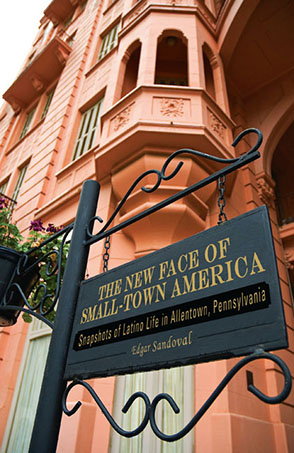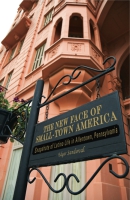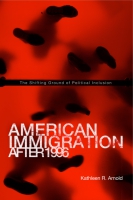
The New Face of Small-Town America
Snapshots of Latino Life in Allentown, Pennsylvania
Edgar Sandoval
The New Face of Small-Town America
Snapshots of Latino Life in Allentown, Pennsylvania
Edgar Sandoval
“The New Face of Small-Town America offers vivid portraits of the people and families behind the demographic statistics, revealing a little-known aspect of contemporary immigration: far from the big cities and the border towns, in small inland settlements often written off as victims of deindustrialization, Latinos are restoring public life, renewing entire communities, and working hard to build a new urban future for our pluralist democracy.”
- Media
- Description
- Reviews
- Bio
- Table of Contents
- Sample Chapters
- Subjects
To read an interview with Edgar Sandoval, click here.
You can also follow him on twitter at @edjsandoval.These small cities have already experienced, or are about to experience, the transformation Allentown saw. Few communities embrace such change. It is only when one becomes familiar with a foreign concept (or foreigners) that fear disappears and understanding begins. Edgar Sandoval’s essays show that behind the accents, ethnic customs, and other cultural differences exists a common humanity with universal problems and dreams. The Latinos profiled here want what everybody else wants: to fit in, to prosper, to offer their children a better future, to be recognized as important members of society by the mainstream. They want to coexist. These stories are not just about Latinos in Allentown, after all; they are about Latinos everywhere.
“The New Face of Small-Town America offers vivid portraits of the people and families behind the demographic statistics, revealing a little-known aspect of contemporary immigration: far from the big cities and the border towns, in small inland settlements often written off as victims of deindustrialization, Latinos are restoring public life, renewing entire communities, and working hard to build a new urban future for our pluralist democracy.”
“In the tradition of Barbara Ehrenreich’s Nickeled and Dimed, Eric Schlosser’s Fast Food Nation, and Isabel Valle’s Fields of Toil, Edgar Sandoval’s accounting of Latinos in Allentown is not just a set of stories worthy of coverage; it’s a window into how public sociology is emboldened by reading those who live, eat, and breathe in the communities they cover. Sandoval’s stories are a form of knowledge that should be neither dismissed nor discounted.”
“The author presents many interviews from all sides of the cultural challenges and gives readers a sense of how life has been modified and improving in recent years in this community.”
Edgar Sandoval is an award-winning journalist who spent almost three years writing about the Latino community of northeastern Pennsylvania. He has been a staff reporter at several newspapers, including the McAllen Monitor, the Allentown Morning Call, the Los Angeles Times, the South Florida Sun-Sentinel, and the New York Daily News, where he is currently employed.
Contents
Preface
Acknowledgments
1. The Ritual
2. A Principal Duty
3. Spanish Sound Bites
4. Home Away from Home
5. Little Hero
6. Music to Their Ears
7. Priceless
8. The Fearful Side of Business
9. Side by Side
10. Blatinos
11. Julio
12. Colorful Pages
13. ABCs
14. Grading the Parents
15. Latino Medicine
16. Hooked on Telenovelas
17. A Step Behind
18. City Boys
19. Spanglish
20. The World Trade Connection
21. Latinos Again
22. One Man, One Mission
23. Down to Business
24. Airwave Wars
25. Goooaaalll!!!
26. Unfulfilled Dreams
27. A Rich Life
28. Liberty and Justice for All
29. Man of the Cross
30. Full Circle
31. Finding the Inner Snowman
Appendix
Index
Preface
Allentown. Billy Joel. Allentown. Billy Joel. Whenever I told people I was moving to Allentown in the year 2000, people tended to lean back, smile, and recite a few lines from Billy Joel’s hit ’80s song of the same name, “Allentown.” It was almost as if strangers and friends alike rehearsed their reaction to my moving news:
Every child has a pretty good shot To get at least as far as their old man got But something happened on the way to that place They threw an American flag in our face Well I'm living here in Allentow
I had never heard of such a song, having been raised in Mexico. So I decided to research it, after the insistence of people I knew. “Oh, you have to listen to the song,” they told me.
The song describes a town dying slowly, as its factories closed down in the 1980s. Allentown and the greater Lehigh Valley in northeastern Pennsylvania had become stagnant, the song lyrics cried out. It was my turn to find out firsthand.
I made my way to Allentown on a crisp morning in September 2000. At first I thought I had driven to the wrong Allentown, since it was my first time to the Northeast. I had heard of another Allentown in New Jersey, after all. But my confusion was really caused by my song research.
I did not see the closed-down factories and depressed, middle-aged men and women standing out on their porches that Billy Joel sang of, holding their high school diplomas and wondering what they were good for. I saw something completely different. I was told there were Latinos here, sure. That’s why I was chosen to come here, to write about them. But I was not ready for what I saw.
I heard salsa blasting from home windows. I saw Puerto Rican flags hanging from doors, cars, and even backpacks. The all-American 7-Elevens had been replaced by bodegas, it seemed. Allentown looked more like a small version of West Side Story than an American coal-mining town. Latin-Town seemed a more fitting name.
Yet this was the right Allentown. A few days later, my new newspaper editor, Mary Ellen Alu, walked with me outside the office and pointed to the streets. “We need you [to] reach out to the Latino community,” she told me.
As it turned out, the local Latino residents were not thrilled with their portrayal in the local media. They always appeared to be present when something went awry. And they had the headlines to prove it: stabbings, rowdy parades, poverty, and so on. They were a stereotype, not people with hopes and dreams, they told me.
Many of the white residents weren’t crazy about their new neighbors. Latinos had left New York, New Jersey, and Latin America to look for an American way of life in the ’80s and ’90s. They settled here, but the influx was not without setbacks. Schools weren’t ready for Spanish-speaking students, and grades dropped like the winter temperature here. Puerto Rican parades ended in chaos, often with police involvement. Resident-imposed neighborhood segregation quickly followed./p>
I arrived in the midst of the tension. And so, I grabbed a notebook and took a few deep breaths before I headed out to the streets to start giving a more complete vision of the city’s outcasts. I wasn’t the only one asking questions, however. The majority of Latinos here come from Caribbean countries. Many of them seemed puzzled by my arrival. They asked, “Where are you from?” “What kind of Spanish accent is that?” “How come they didn’t hire a Puerto Rican to cover us?”
In the eyes of the white world here, I was one of them. In the eyes of the community I was hired to write about, I was not really like them. Sure, I spoke their language, shared a similar skin color, and had an accent, not like theirs, but definitely different than the mainstream here. As far as they knew, I was just a foreigner with a similar vocabulary.
I had to brush up on my cultural skills in a hurry. I began to understand that the nice man behind the bakery counter was not calling me bad names—he was asking me if I wanted to buy one of his pastries. (You would be surprised how many words may sound innocent in one Latin culture, but have an offensive meaning in another.) It took some mutual adjustment, but being of Mexican descent proved beneficial. Because I am not Caribbean, cultural differences fascinated and enthralled me. I wrote about Caribbean Latinos the same way an anthropologist writes about a newly discovered culture.
In the end, I’d like to think it all turned out for the best. Latinos began reading about people like them in the newspaper. Members of the mainstream began to learn more about their neighbors, often at the same time I did. Latinos here are doing better than ever before—and local residents recognize their buying power. Latino children are seen as the future now, not the unwanted problem. Allentown now has its first Latino immigrant councilman and more Latino professionals and role models than the city has seen in years.
And so here are the stories of the new faces of Allentown. Latinos make up about a quarter of the city’s population, and their numbers continue to grow in the greater Lehigh Valley. But this is not the story of Allentown alone. With the U.S. Census figures showing the arrival of Latinos in more small American cities than ever before, Allentown will continue to serve as an example. Small American cities everywhere have already experienced, or are about to experience, the transformation Allentown saw mostly in this last decade. Few people like change and the unknown. It is only when you become familiar with a foreign concept (or foreigners) that fear disappears and understanding begins. You will discover that behind the accents, ethnic customs, and other cultural differences, we all, as members of the human race, share universal problems and dreams. The Latinos I profiled here want what everybody else wants: to fit in, to prosper, to offer their children a better future, to be recognized as important members of society by the mainstream. They want to coexist. These stories are not just about Latinos in Allentown, after all, they are about Latinos everywhere.
Maybe Billy Joel was right. Allentown had been dormant. Allentown did see a revival. Not the revival everyone hoped for, but one many are learning to accept.
© 2010 Penn State University
Also of Interest
Mailing List
Subscribe to our mailing list and be notified about new titles, journals and catalogs.




